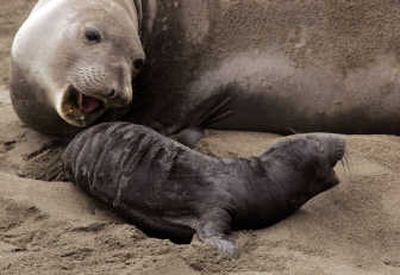Where the blubber meets the road

SAN SIMEON, Calif. – This time each year, hundreds of croaking, roaring, shrieking elephant seals gather to breed and give birth on the rocky shoreline below Hearst Castle.
The boisterous annual show draws hordes of tourists to a boardwalk 15 feet above, where they can watch the enormous pinnipeds tend the shiny black pups, squabble over beach space and battle for the right to mate.
But this year, the traffic jams near the Piedras Blancas birthing grounds aren’t being caused just by curious motorists.
Some of the seals are sneaking past barbed-wire fences designed to protect them, then flopping on blubbery bellies right across California 1.
Their dangerous behavior has police and seal-lovers worried.
“When a 4,700-pound pickup truck meets a 5,000-pound seal, they both lose,” said Ken Cumings, a docent with Friends of the Elephant Seal.
In recent weeks, at least four of the animals have attempted great escapes.
In December, a motorist struck and killed one of the federally protected mammals. Then a female seal crossed the fence line for a few hours before being herded back to the beach.
A few days later, a male seal, nicknamed Lucky, got to the other side of the road by way of a culvert and took up residence for 10 days on the Hearst Ranch property.
It took a team of biologists, rangers and police in four-wheel-drive trucks to finally coax Lucky back to his mates across the two-lane highway. Last week, another seal was reported on the Hearst Ranch property, but the animal appeared to make it back to the beach on its own.
The encounters have left local officials scratching their heads over how to keep the highway safe while protecting the thousands of seals that return to Piedras Blancas each winter.
The phenomenon of wandering seals isn’t entirely new. Seals and motorists have had encounters before. Seals have been killed and drivers injured.
But Brian Hatfield, a biologist with the U.S. Geological Survey who has watched the rookery grow from a few seals in 1990 to an estimated 16,000 this year, said it had become more of a problem as the population exploded.
“This year seems to be particularly bad,” Hatfield said. “I’m not sure if it’s overcrowding or if the barriers have just eroded.”
The Piedras Blancas birthing ground is one of an estimated 17 rookeries dotting the Pacific coast and offshore islands from the Gulf of Alaska to Baja, Mexico.
Piedras Blancas is one of the newest – and the only one next to a major highway.
Tourists are treated to an unparalleled look at the social animals, and mating season is when they are at their antic best, docents say.
Big bull seals, alpha males with distinct, long elephantine noses, battle for the right to dominate large harems. Quarrels over where one harem ends and another begins break out with regularity, sometimes resulting in bloody fights. Females, meanwhile, squabble over prime beach space while slick black newborn pups screech for attention.
About 10 years ago, the California Department of Transportation realigned California 1 near the rookery and installed a large public parking lot and viewing area for motorists. It also put up barbed-wire fencing in an attempt to reduce accidents.
Transportation officials are planning to repair broken fences and place grates over the culverts to minimize the possibility of future escapes, said spokesman Jim Shivers.